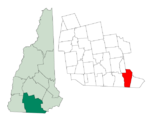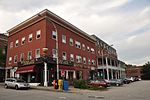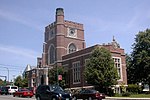Hudson (CDP), New Hampshire
Census-designated places in Hillsborough County, New HampshireCensus-designated places in New Hampshire

Hudson is a census-designated place (CDP) and the urban center of the town of Hudson in Hillsborough County, New Hampshire, United States. The population of the CDP was 7,534 at the 2020 census, out of 25,394 in the entire town.
Excerpt from the Wikipedia article Hudson (CDP), New Hampshire (License: CC BY-SA 3.0, Authors, Images).Hudson (CDP), New Hampshire
Ferry Street,
Geographical coordinates (GPS) Address Nearby Places Show on map
Geographical coordinates (GPS)
| Latitude | Longitude |
|---|---|
| N 42.764722222222 ° | E -71.439722222222 ° |
Address
Ferry Street 29
03051
New Hampshire, United States
Open on Google Maps










